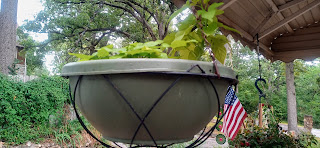Sweet potato vine is an easy-to-grow
houseplant but it also can be grown outdoors during the summer months. Then bring it indoors during the cool and
cold months and it will add lovely green color to your space.
Normally I do not plant anything
during the peak summer when the heat is extreme. But that does not mean that it cannot be
done. Today my brother surprised me with sweet potato vines. He saw them at
Lowes and knew they would make a pretty plant for a hanging container so he
bought it for me.
I planted my vines in a hanging basket. I used miracle-grow potting soil and amended
the soil with some manure. Two vines
were planted in the container so that there would be ample space. After the vines were planted, I watered them
well and found the drainage holes at the bottom of the container were
okay.
Cedar mulch was added around the
plants to help keep the soil moist since dry soil would be hard on a newly
planted sweet potato vine.
I hung the container on my porch where
the plants would get six hours of light per day. Morning sun is best if your
area is extremely hot. My porch has
shade in the afternoon and then some sun at the end of the day. As a rule sweet potato vine needs 6 hours of
sun but will tolerate partial sun.
If you plan on growing your sweet
potato vine indoors then set the container near a sunny window where the plant
can get 6 hours of sun per day. Water to
keep the soil moist but not soggy.
If your plant gets too full or vines
too long you can trim to control the growth and to keep the plant's shape.
















